Crunchy, tangy, and pleasantly salty — these fermented dill pickles are the perfect gut-healthy treat for summer. All you need are fresh pickling cucumbers, a few herbs and spices, salt, water, a little patience, and some warmth.
Summer Pickles
Where I’m from in Romania, we call them “summer pickles” because they’re made only during the hot days of the year, when cucumbers are small, vibrant, slightly underripe, and at their peak freshness. My grandpa didn’t cook much, but every summer he made a big jar of these pickles from cucumbers grown in our garden — it was his specialty. My dad still makes them every year.
They’re a summer-only tradition for two reasons: you need both heat and the right cucumbers. In the Northern Hemisphere, pickling cucumbers are in season in July and August.
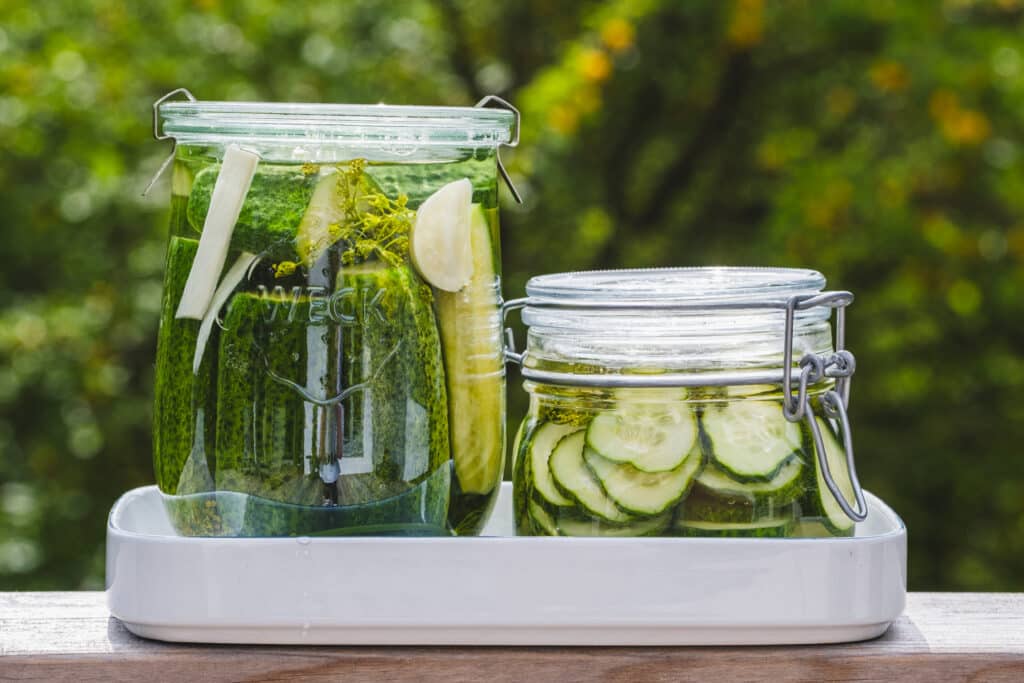
Pickling vs. Fermentation
Pickling can be a confusing topic. While you can pickle or ferment almost any vegetable, the word “pickles” in many places has come to mean canned cucumbers preserved in vinegar and sugar. That method creates a familiar sweet and sour flavor, but it’s not the same as fermentation. In fact, it is quite the opposite: while the process of fermentation encourages the development of beneficial bacteria, vinegar and sugar inhibit it.
Fermentation — especially lacto-fermentation — is one of the oldest and safest ways to preserve food. It doesn’t just extend shelf life; it transforms the food nutritionally. Naturally occurring Lactobacillus bacteria convert the sugars in fruits and vegetables into lactic acid, a natural preservative that inhibits harmful bacteria while preserving flavor, texture, and nutrients.
During this process, anti-nutrients are reduced, mineral absorption is improved, and beneficial micronutrients unique to fermentation are created. This is also one of the methods that helps reduce lectins in lectin-rich foods (such as cucumbers).
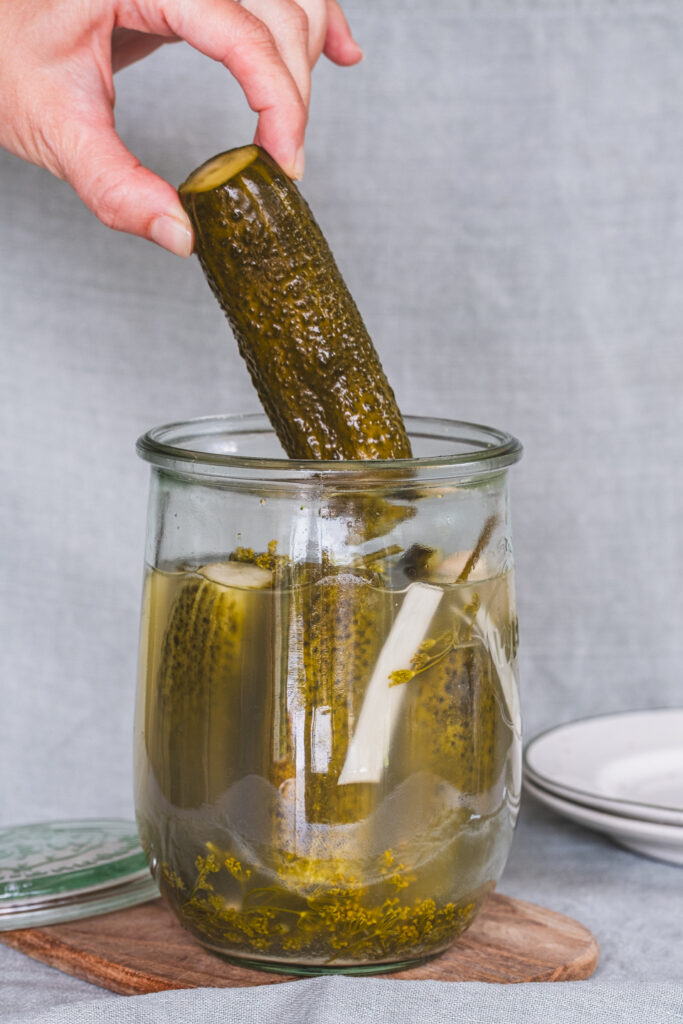
Prebiotics and Postbiotics
For a long time, it was thought that the live bacterial cultures that support gut health are only present in raw, unheated ferments. This meant that store-bought “fermented” vegetables that have been pasteurized, or products of fermentation that have been exposed to high heat, like sourdough bread, or miso paste in a hot soup, no longer offer those benefits.
However, a 2022 study found that heat‑killed probiotic bacteria — now called postbiotics — can still influence the gut microbiota, even when they’re no longer alive. “Non-viable probiotic products show similar potential health benefits to viable bacteria.”
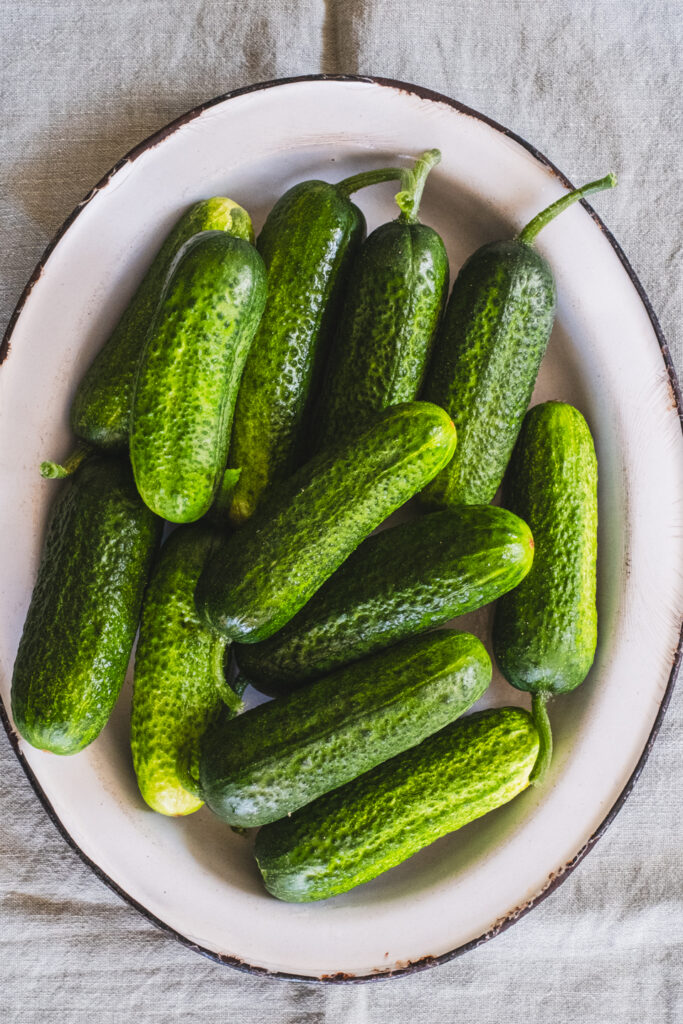
Lacto-Fermented Dill Pickles: Tips for Success
Use clean utensils and jars – I don’t always sterilize my jars, but I wash them thoroughly with hot water and let them air-dry or dry them with a clean cotton towel.
Choose proper lids, not cloth or paper – Cloth or paper can be difficult to keep clean during fermentation. A glass or plastic lid keeps contaminants out while still allowing airflow.
Pick the right cucumbers – Use organic, freshly picked pickling cucumbers. They should be small, vibrant green, and slightly bumpy. Trim the tips before pickling for better fermentation and crisp texture.
Select the right salt – Use minimally processed salt without iodine or anti-caking agents. Rock salt, kosher salt, or Himalayan pink salt work well.
Weigh your salt – Because salt crystal sizes vary, measure by weight, not volume. Use 30 g (1 oz) salt per 1 L (4¼ cups) water.
Use the best water possible – Spring water or clean, chlorine- and fluoride-free tap water is ideal. In Denmark, my tap water works well; in Romania, my dad uses spring water because his tap water is heavily chlorinated.
Prevent jar cracking – When pouring hot brine, place a metal knife under the jar to absorb some of the heat and reduce the risk of cracking.
Experiment with flavors – My favorites are dill blossoms, horseradish, and sometimes garlic. You can also try mustard seeds, peppercorns, or bay leaves. Test small batches to find your preferred flavor.
Decide on the shape – You can pickle whole cucumbers (tips removed), slice them into rounds, or cut them lengthwise. Use separate jars or mix shapes in the same jar.
Fermentation time – At 72–74°F (22–23°C), fermentation takes about 5 days. In Eastern Europe, these are called “sun pickles,” but I recommend avoiding direct sunlight, which can encourage mold. They need warmth, not direct sun.
What to expect – The brine will get cloudy after the first day; this is normal. Signs of spoilage include mold, foul odor, or slimy brine. Finished pickles should be crunchy, with a deep olive-green color. They should have a pleasantly salty flavor, bright and tangy, with the floral notes so specific to dill blossoms.
Store properly – Once fermented to your taste, refrigerate in the same jar. If reusing the jar for a new batch, transfer pickles and brine to a clean glass or stainless-steel container with a lid. They’ll keep for several weeks.
Reuse the brine – Add 1–2 tablespoons of brine from the last batch to the cooled brine in your new jar to kickstart fermentation.
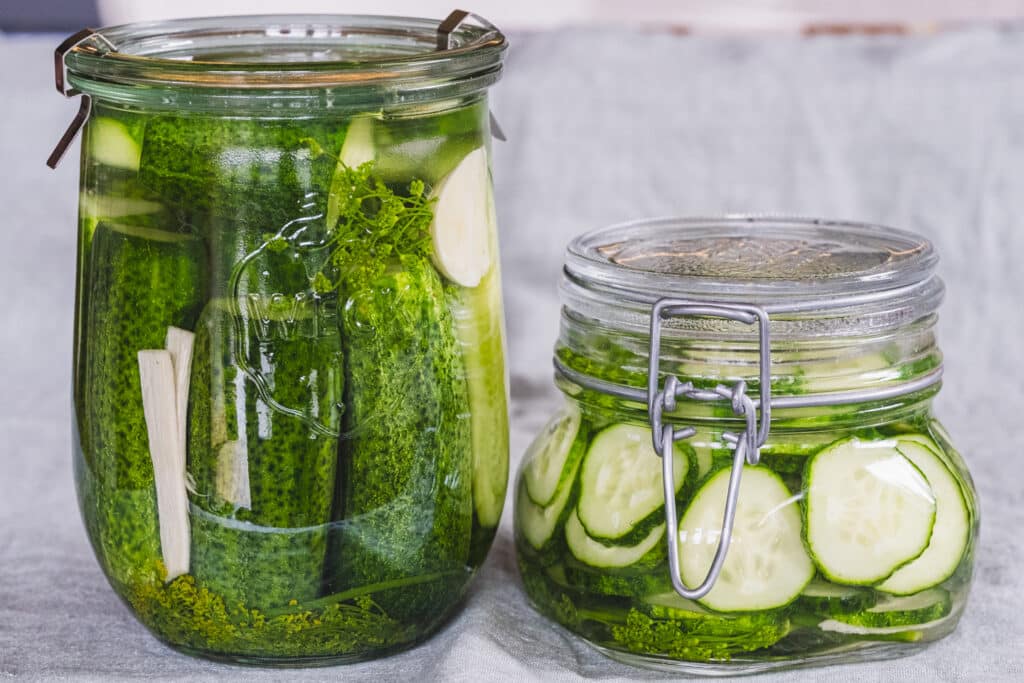
What You Need
- 2 L (½ gallon) Mason or Weck jar, or 2 smaller jars
- 1 kg (2.2 lb) pickling cucumbers, fresh and organic
- 1.5 L (6⅓ cups) spring or non-chlorinated water
- 45 g (1.6 oz / 2½ tbsp) non-iodized salt
- A handful of dill flowers/blossoms, fresh or dried
- Optional Add-Ins: 1–2 garlic cloves, horseradish root (small sticks), 1 bay leaf, mustard seeds or peppercorns (I use horseradish and garlic)
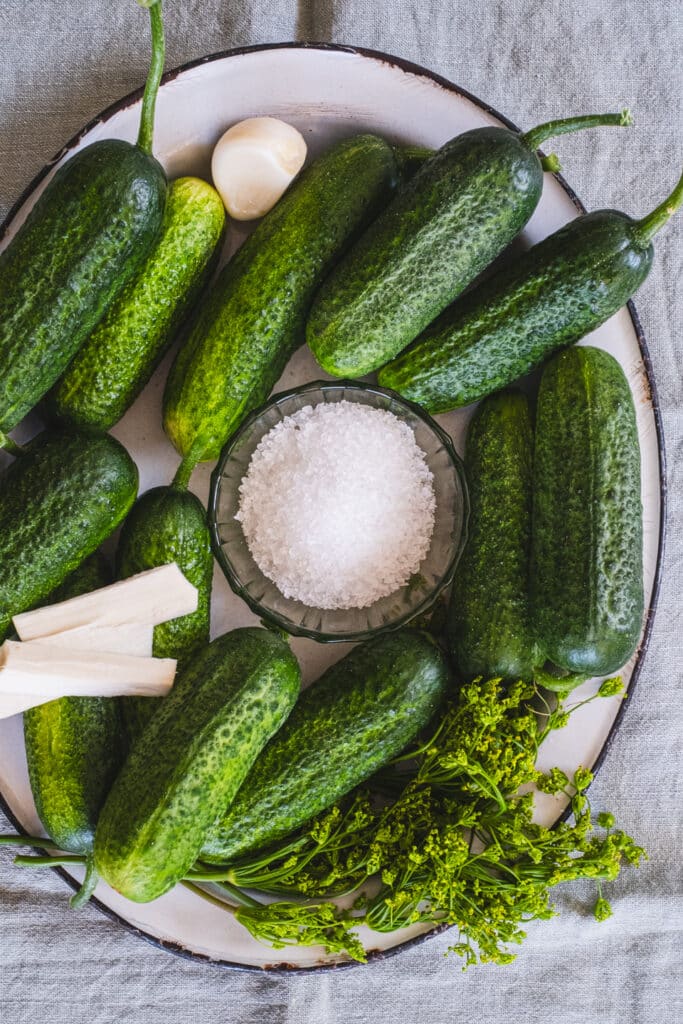
How to Make Fermented Dill Pickles (Summer Pickles)
Clean and dry the jar (sterilize if needed).
Wash cucumbers under running water, pat dry, and trim the ends. Rinse dill flowers if fresh, then pat dry. Prepare optional add-ins (garlic, horseradish, bay leaf).
Bring water to a boil, stir in salt until dissolved, then remove from heat.
Place most of the dill at the bottom of the jar. Pack cucumbers tightly, filling gaps with halved cucumbers if needed. Add more dill on top, and insert a few horseradish sticks and 1-2 garlic cloves in the gaps. If you want to pickle some sliced cucumbers, like I did, follow the same steps.
Pour hot brine over cucumbers (place a knife under the jar to prevent cracking), ensuring they are fully submerged.
Seal loosely (not airtight) and ferment at room temperature for about 5 days, or until desired sourness is reached. The brine will turn cloudy — this is normal. What is NOT normal is mold, foul odor, or slimy brine.
Once fermented, seal tightly and refrigerate for up to 1 month.
Tip: A little brine from this batch can be used to start the next batch.
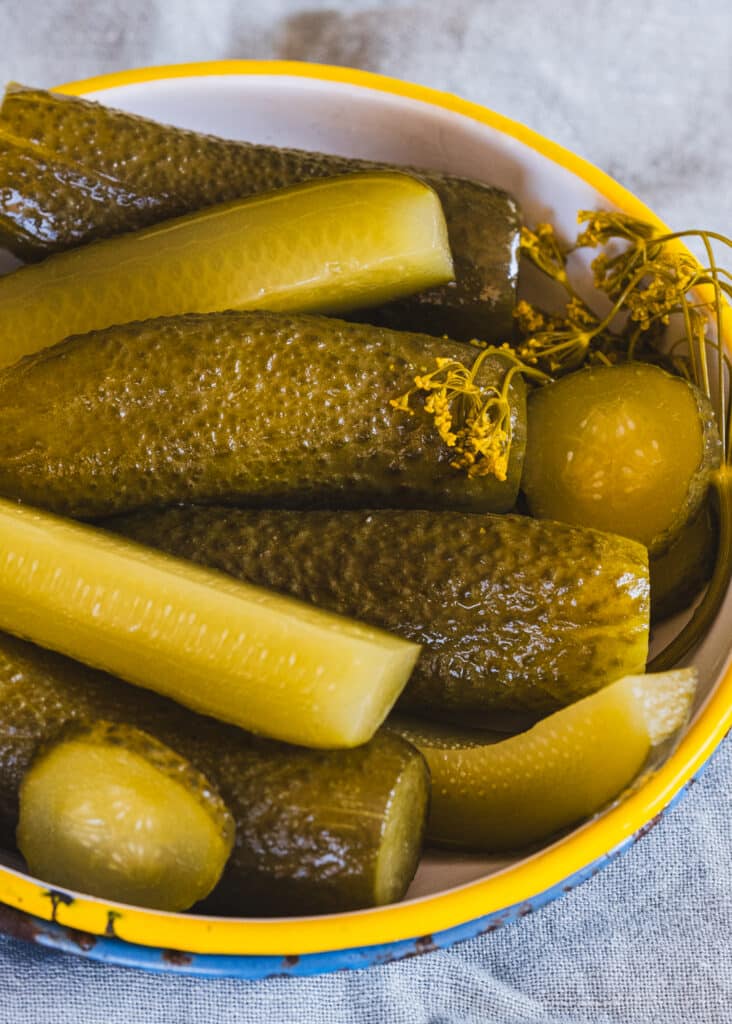
More Fermented Vegetables
If you want to introduce more probiotics and postbiotics into your diet, check out two of my favorite fermented vegetable recipes:
- Mixed Fermented Vegetables: Easy Recipe and Tips
- Red Cabbage Sauerkraut: A Simple Way to Explore Basic Fermentation
*This post contains affiliated links, which means I get a small commission if you choose to purchase something via one of my links, at no extra cost to you.
Print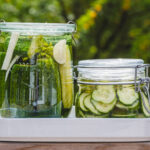
Fermented Dill Pickles (Summer Pickles)
- Prep Time: 20 minutes
- Fermentation Time: 5 Days
- Cook Time: 15 minutes
- Total Time: 120 hours 35 minutes
- Yield: 12 servings
Description
Crunchy, tangy, and pleasantly salty — these fermented dill pickles are the perfect gut-healthy treat for summer. All you need are fresh pickling cucumbers, a few herbs and spices, salt, water, a little patience, and some warmth.
Ingredients
- Tools: 2 L (½ gallon) Mason or Weck jar, or 2 smaller jars
- 1 kg (2.2 lb) pickling cucumbers, fresh and organic
- 1.5 L (6⅓ cups) spring or non-chlorinated water
- 45 g (1.6 oz / 2½ tbsp) non-iodized salt
- A handful of dill flowers / blossom, fresh or dried
- Optional: 1–2 garlic cloves, horseradish root (small sticks), 1 bay leaf, mustard seeds or peppercorns (I use horseradish and garlic)
Instructions
- Clean and dry the jar (sterilize if needed).
- Wash cucumbers under running water, pat dry, and trim the ends.
- Rinse dill flowers if fresh, then pat dry.
- Prepare optional add-ins (garlic, horseradish, bay leaf).
- Bring water to a boil, stir in salt until dissolved, then remove from heat.
- Place most of the dill at the bottom of the jar. Pack cucumbers tightly, filling gaps with halved cucumbers if needed. Add more dill on top, and insert a few horseradish sticks and 1-2 garlic cloves in the gaps. If you want to pickle some sliced cucumbers, like I did, follow the same steps.
- Pour hot brine over cucumbers (place a knife under the jar to prevent cracking), ensuring they are fully submerged.
- Seal loosely (not airtight) and ferment at room temperature for about 5 days, or until desired sourness is reached. The brine will turn cloudy — this is normal. What is NOT normal is mold, foul odor, or slimy brine.
- Once fermented, seal tightly and refrigerate for up to 1 month.
- Tip: A little brine from this batch can be used to start the next batch.
Notes
To adjust quantities, use 30g salt per 1L water. For a 2L (½ gallon) jar, you’ll need about 1 kg (2.2 lb) cucumbers if pickling them whole. You can use this same recipe and process for either whole cucumbers or sliced cucumbers.
Choose a salt that is minimally processed, has no iodine or anti-caking agents. Rock salt, kosher salt, hymalaian pink salt are great options.
Spring water, or tap water that has no chlorine or fluoride is ideal for lacto-fermentation.
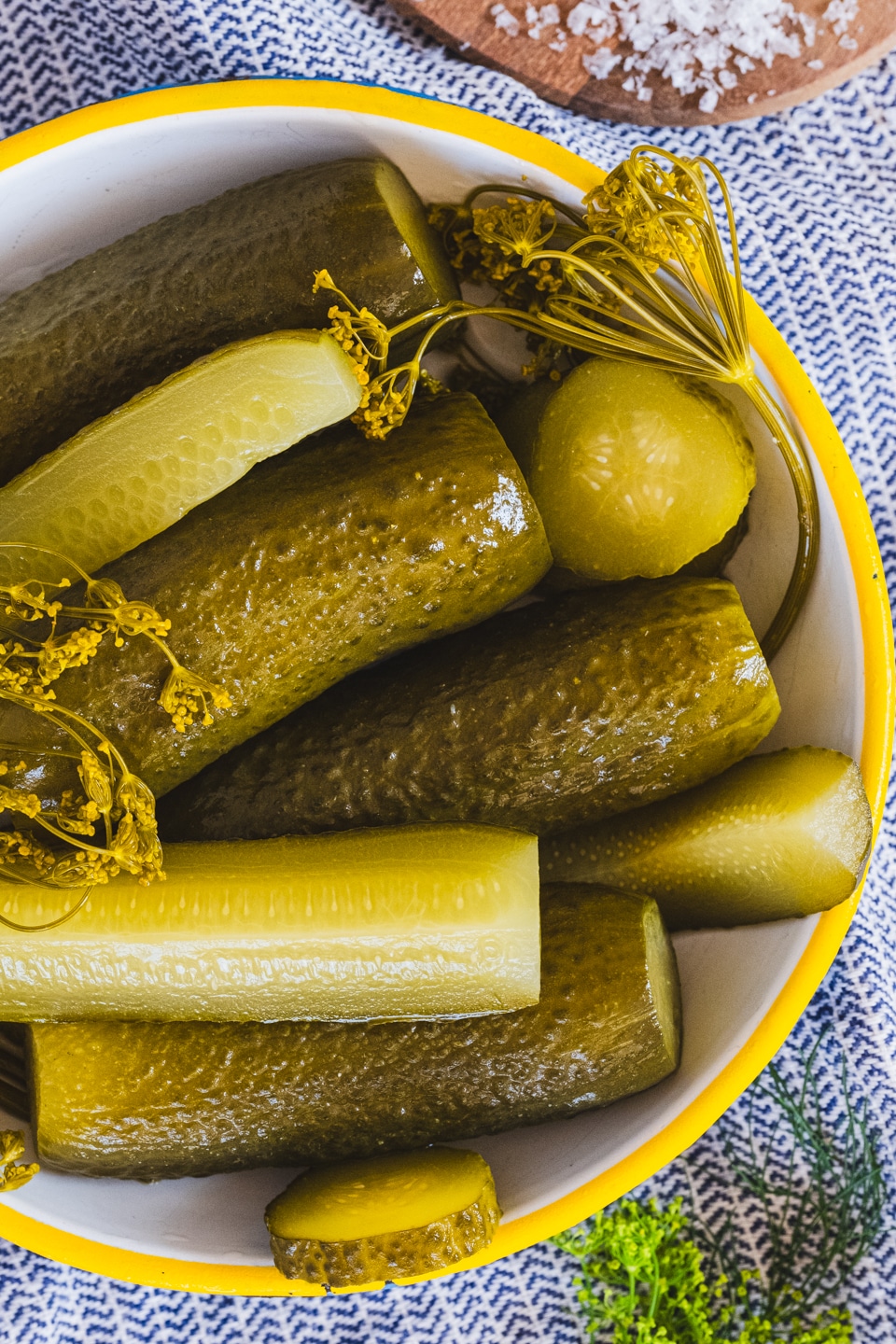
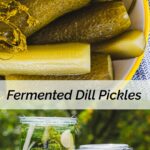
No Comments